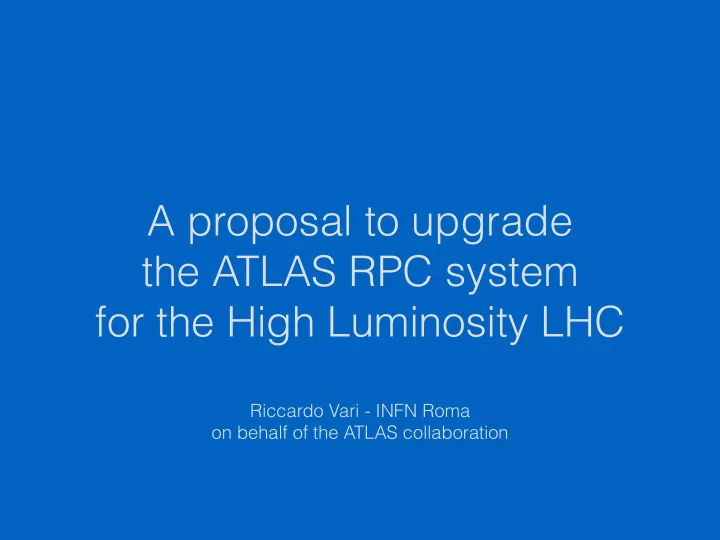

A proposal to upgrade the ATLAS RPC system for the High Luminosity LHC Riccardo Vari - INFN Roma on behalf of the ATLAS collaboration
The current ATLAS RPC Muon Barrel System • The barrel trigger algorithm is based on hit coincidence of three concentric RPC stations (two in the Barrel Middle region and one in the Barrel Outer region). • The Low-p T trigger (< 10 GeV) makes use of the two BM stations, while the High-p T trigger (> 10 GeV) requires an additional confirmation on the BO station. • RPC geometrical coverage: - RPC detector coverage is limited to 73% because of the ATLAS mechanical support structures (toroid ribs in small sectors of BM, toroid feet in the lower part of the barrel); - one possibility to increase the current detector coverage is to install additional RPC BO MDT chambers in the Barrel Inner region, where there are no mechanical structures. RPC 3 high p T RPC 2 (pivot) BM MDT MDT • RPC rate capability: MDT low p RPC 1 T BI MDT - current detector was developed to stand 10 years of LHC operations at nominal luminosity of L=10^34 cm-2 s-1; - detector longevity has been certified for a nominal hit rate of 100 Hz/cm2 including 10 15 m 0 5 safety factors (ageing test done in accelerated conditions showed that the design rate limit cannot be exceeded); L1 muon barrel trigger efficiency φ - an extrapolation of 2012 data to Phase-II LHC luminosity (7*10^34 cm-2 s-1) foresees a hit rate of ~150 Hz/cm2 in average, ~300 Hz/cm2 in the hottest sectors. - RPC HV working point will have to be lowered to limit the hit rate and to avoid detector degradation; - an additional RPC layer in the BI region could allow to recover the lowered efficiency ATLAS Preliminary and to increase the barrel trigger performances. η 2
New RPC inner layer proposal for HL-LHC • The insertion of a new RPC inner layer (triplet or quadruplet) allows to increase the current detector coverage up to 96%. • Increased trigger redundancy and robustness: from 3 to 4 concentric RPC chambers, from 6 to 10 layers. new RPC0 inner layer • The increased redundancy allows to cope with the HL-LHC foreseen RPC hit rates: current RPC efficiency ~73% hits on (RPC1 and RPC2 and RPC3) required RPC3 - the BM station (RPC1 and RPC2) can be used with a 2/4 Not reviewed, for internal circulation only majority instead of the 3/4; RPC2 RPC1 - this allows to change the old RPC HV operating point (reduced gap efficiency) to a safe value, without affecting the RPC efficiency ~88% hits on (any 3 out of 4) RPCs required trigger efficiency. RPC3 Not reviewed, for internal circulation only RPC2 • The new generation of RPCs can work at hit rates > 20 kHz/cm2. RPC1 RPC0 • Pileup insensitive due to high space-time RPC granularity ~0.5 RPC efficiency ~96% cm2 x 0.5 ns. hits on (any 3 out of 4) OR inner layer RPC0 required RPC3 Not reviewed, for internal circulation only • The increased lever arm allows for a sharper momentum RPC2 RPC1 threshold. RPC0 3
Recommend
More recommend